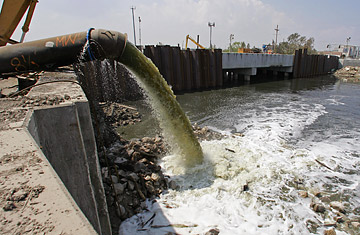
Water pumped into Lake Pontchartrain drains into the Gulf of Mexico
The American Midwest is essentially the granary of the world, supplying corn, wheat and other crops to markets from Chile to China. But all that food doesn't grow by itself. In 2006 U.S. farmers used more than 21 million tons of nitrogen, phosphorus and other fertilizers to boost their crops, and all those chemicals have consequences far beyond the immediate area. When the spring rains come, fertilizer from Midwestern farms drains into the Mississippi river system and down to Louisiana, where the agricultural sewage pours into the Gulf of Mexico. Just as fertilizer speeds the growth of plants on land, the chemicals enhance the rapid development of algae in the water. When the algae die and decompose, the process sucks all the oxygen out of the surrounding waters, leading to a hypoxic event — better known as a "dead zone." The water becomes as barren as the surface of the moon. What sea life that can flee the zone does so; what can't, dies.
Since 1990 the dead zone, which begins in summer and lasts until early fall, has averaged about 6,046 sq. mi. But the threat is growing. A study released last week by scientists from Louisiana State University (LSU) and the Louisiana Universities Marine Consortium estimated that this year's dead zone would be more than 10,000 sq. mi., roughly the size of Massachusetts. But that prediction was made before massive floods hit the Midwest: with the flow of the Mississippi at dangerous levels, and with rains sweeping fertilizer off drowned farms, the dead zone could grow even bigger. The Louisiana fishing industry, the second largest in the nation, is already hurting, with shrimp catches falling in the dead zone's wake. The U.S. is not alone in grappling with this aquatic byproduct. As modern, chemically intensive agricultural practices spread around the globe, so does hypoxia; a 2004 U.N. report documents nearly 150 dead zones globally. But none compare to the black hole in the Gulf of Mexico. "This year would be the largest since we've started keeping records," says R. Eugene Turner, a zoologist with LSU who led the modeling effort. "It's definitely getting worse."
In response to the growing problem, the Environmental Protection Agency (EPA) — along with several other federal groups and the governments of states that feed into the Mississippi — released a plan of attack on Monday to reduce the Gulf's dead zone. The plan, an update of an effort launched in the waning days of the Clinton Administration in 2001, looks to harness state and federal action to reduce the flow of fertilizer into the Mississippi, much of which comes from agricultural sources that aren't covered by the regulations of the Clean Water Act. The ultimate goal is to shrink the size of the dead zone, averaged over five years, to 1,930 sq. mi. or less by 2015 — considerably smaller than the 7,900 sq. mi. the zone reached last year. "This plan has greater accountability and specificity [than 2001]," says Benjamin Grumbles, the EPA's assistant administrator for water. "This is urgent."
But not so urgent that the government seems ready to spend what it would take to truly revive the dead zone. Although Grumbles points out that an action plan isn't the same thing as a budget allocation, there's little evidence that anyone is prepared to bear the financial burden of drastically reducing fertilizer runoff in the Midwest. (It doesn't help that 31 states feed into the Mississippi River basin, or that multiple federal agencies are involved with the dead-zone task force.) A 2007 report by the National Research Council called for more aggressive leadership by the EPA to coordinate and oversee state activities along the Mississippi, but the agency doesn't seem ready or able to seize that role. The plan itself reports that "resources are insufficient to gain the goals" of the task force. "We seem to be going in the opposite direction," says Donald Scavia, a professor of natural resources and the environment at the University of Michigan. "We don't seem committed to fixing the problem."
Not that it's an easy one to fix. Most of the nutrient pollution that ends up in the Gulf comes from the hundreds of thousands of farms in the Midwest. The only sure way to shrink the dead zone is to reduce the amount of fertilizer running off those farms. But thanks in part to the push for corn-based ethanol and the skyrocketing price of food crops, U.S. farmers are planting more acres for corn than they have since World War II — including 15 million more acres last year than in 2006. Although there are measures farmers can take to limit fertilizer runoff, those changes are expensive, and there's little federal funding to support such conservation. The just-released action plan relies mostly on voluntary activities. "We need Congress to act as if this is going to get done," says Doug Daigle, a member of the task force. "The state governments will contribute, but this has to be initiated by the Federal Government."
Unfortunately, the dead zone isn't simply an environmental failure, but also a consequence of our national agricultural policy, which subsidizes farmers to grow vast, heavily fertilized quantities of corn and other grains. The pork-laden farm bill, which recently passed Congress over President George W. Bush's veto, will only worsen the problem. And even if we can begin to reduce the future flow of fertilizer, repeated dead zones are having a cumulative effect, with smaller amounts of nitrates and other chemicals in the Gulf having a larger hypoxic impact than in the past. "We have to decide how much we're willing to spend to save the Gulf fisheries," says Daigle. "Right now, we don't seem to be willing to invest much." Put simply, the Gulf is running out of air — and we're running out of time to fix it.
